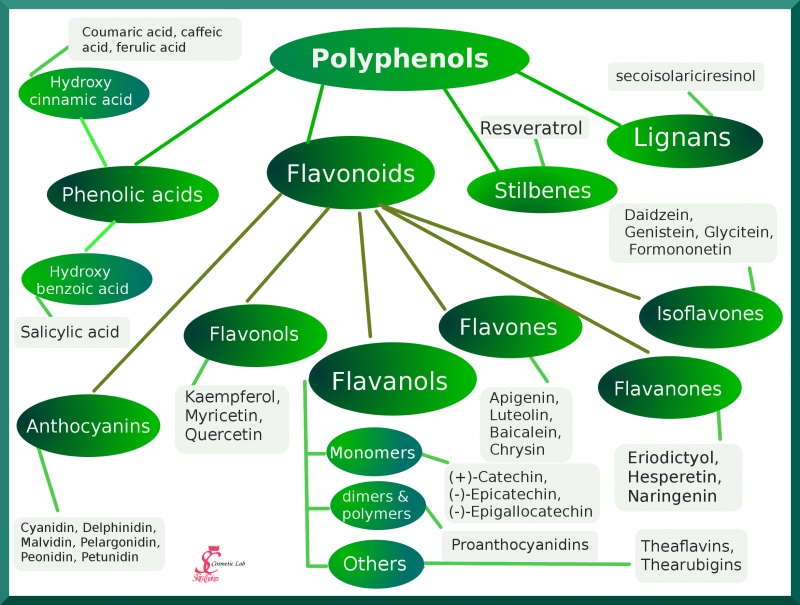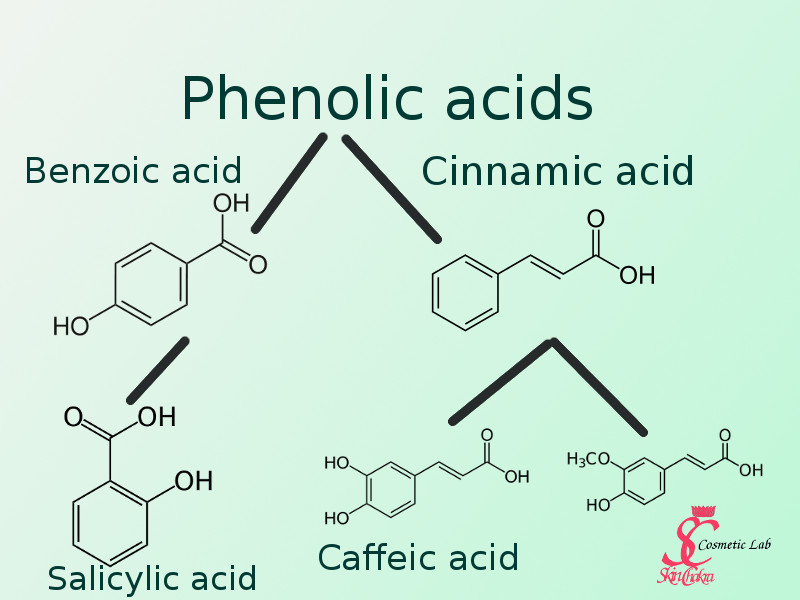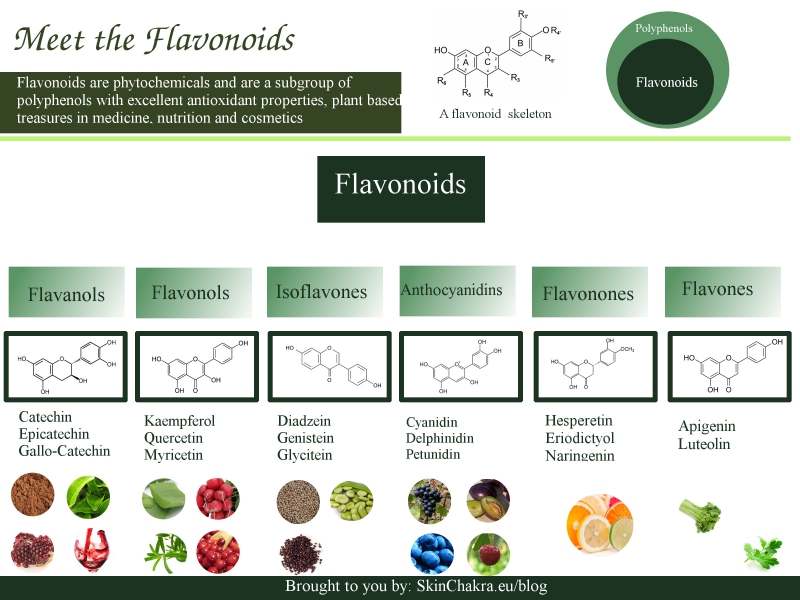
Sonntag, 22. Mai 2016
Plant Extracts 101(Part V): Phytochemicals in cosmetics: Polyphenols
In previous part of these series we reviewed terpenoids as a group of secondary plant metabolites. In this part we're going to discuss "polyphenols" which are probably the most fascinating category of plant metabolites and the most widely investigated class from a pharmacologic point of view. Over 8000 polyphenols are so far being investigated.
Polyphenols or "phenolic compounds" are based on a small aromatic group, "phenol" which believe it or not, is a toxic and carcinogenic molecule.
Polyphenols are found in almost every part of plants: roots, leaves, flowers, stems and fruits.
Their main purpose is to protect the plant against UV-light, herbivores or bacterial and fungal infections.
These molecules are extremely important in nutrition, medicine and cosmetics and act as:
- anti-oxidant
- anti-mutagenic, anti-cancer
- anti-fungal
- anti-bacterial
- vasoprotective
- photo-protective
- anti-diabetic
- neuroprotective
Polyphenols are further divided into 4 main subgroups:
- Lignans
- Phenolic acids
- Stilbenes
- Flavonoids
Lignans are basically high molecular weight molecules that are insoluble and are accompanying fibre and hence are available and fibre rich food. Linseed and sesame for example are rich sources of lignans.
Secoisolariciresinol is an example of a lignan (a phytoesterogen) available in linseed for example. Although lignans play an important role in nutrition and in pharmacology, they have little significance in cosmetic applications.
Phenolic acids are further subdivided into two classes:
- Benzoic acid derivatives such as salicylic acid
- Cinnamic acid derivatives such as caffeic acid, ferulic acid and p-coumaric acid
Ferulic acid is the very same precious anti-aging ingredient derived from rice, oats or wheat bran.
Phenolic acid content of plants generally reduces upon storage. These ingredients perform anti-oxidant, anti-ageing, anti-bacteril and anti-fungal properties.
The solubility depends on the pH. These are best extracted in hydralcoholic or hydro-glycolic carriers.
Stilbenes are another subgroup of polyphenols. The best representative of the group is resveratrol, the very famous anti-oxidant found in red grapes and red wine. Stilbenes are soluble in Ethanol.
 Flavonoids are certainly the most exciting and most widely investigated subclass of phenolic compunds. This class contains more than 5000 investigated ingredients at the moment.
Flavonoids are certainly the most exciting and most widely investigated subclass of phenolic compunds. This class contains more than 5000 investigated ingredients at the moment.
Flavonoids have tha flavon backbone in common and are classified to 6 main subgroups.
1-Flavanols are further divided into 3 subgroups:
- monomers such as (+)-Catechin, (-)-Epicatechin, (-)-Epigallocatechin (are called pseudotannins as well) . These are present in tea (specially white tea, green tea and oolong), berries and apples. These are basically water soluble. (and soluble in low concentrations of alcohol).
- dimers and polymers such as proanthocyanidins (condensed tannins) which are present in apples, berries, red wine and red grape. These are water and alcohol soluble
- other molecules such as Theaflavins, Thearubigins. These are fermentation products of flavanols and obviously are found in black tea. These ingredients have anti-oxidant properties and have shown some cholesterol reduction and effectivity against HIV virus. These ingredients are water soluble.
2-Flavonols include Isorhamnetin, Kaempferol, Myricetin, Quercetin and are present in onions, kale, lovage, broccoli, berries, tea, apple
These ingredients are generally insoluble in water but soluble in alcohol or hydroalcoholic solvents (the solubility is pH dependant)
3-Isoflavones such as Daidzein, Genistein, Glycitein, Biochanin A, Formononetin are present in soybean and legumes. Are insoluble in water but soluble in Ethanol and in ydroalcoholic solvents.
4-Anthocyanidins such as Cyanidin, Delphinidin, Malvidin, Pelargonidin, Peonidin, Petunidin are present in red wine, red and blue berries, red & purple grapes. These are the beautiful red to blue pigments (the colour depends on the pH) present in most fruits and some vegetables. These are highly water and ethanol soluble.
5-Flavonones such as Eriodictyol, Hesperetin, Naringenin are present in citrus fruits. These molecules have low water solubility but are soluble in alcohol.
6-Flavones such as Apigenin, Luteolin, Baicalein, Chrysin present in celery, parsely, thyme and pepper. These are highly insoluble in water but partially soluble in hydroalcoholic solvents or in hot alcohol.
I hope you'll find this post helful and useful for application of extracts in your cosmetic formulations. You must have an overview of how to extract your desired active ingredients from each plant now. The rest should be gained with experience and by varying factors such as pH, temperature, solvent blend. Feel free to share this post with your friends and colleagues and feel free to send me your questions and comments. I promise to answer them in a couple of days.I really enjoy your participation in our Facebook discussions.
P.S. I'm sending a solubility diagram for plant material with the June newsletter. Male sure you've subscribes to our newsletter and make sure it doesn't land into your junk mail.
Be Happy and have fun
References:
1-http://lpi.oregonstate.edu/mic/dietary-factors/phytochemicals/flavonoids
2- Pandey, Kanti Bhooshan, and Syed Ibrahim Rizvi. "Plant polyphenols as dietary antioxidants in human health and disease." Oxidative medicine and cellular longevity 2.5 (2009): 270-278.





